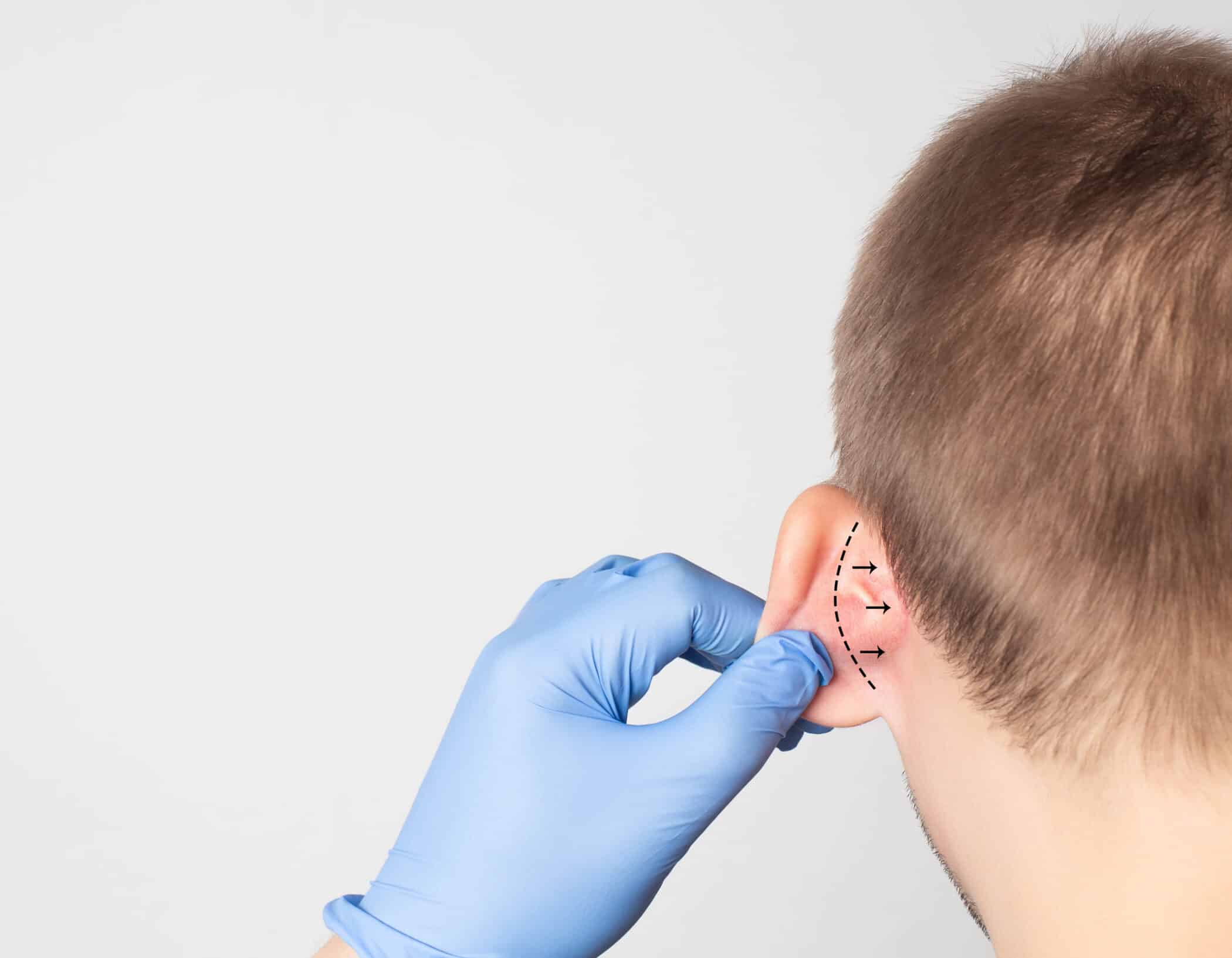Article At A Glance
- Otoplasty is a surgery to enhance ear appearance, suitable for those seeking improved balance and symmetry.
- Risks include infection and scarring, which are reduced with proper care and by following surgeon advice.
- Preparation involves consultation on medical history and planning for recovery support.
- Choose a qualified surgeon with board certification and a successful surgery portfolio.
Otoplasty, commonly referred to as ear pinning surgery, can enhance the appearance of your ears, helping to create a more balanced look that complements your facial features. If you’re an adult aiming to refine your appearance or a parent considering surgery for your child, it’s crucial to understand all aspects of this cosmetic procedure.
This comprehensive guide will address various types of otoplasty, its benefits, preparation, recovery expectations, and how to choose a qualified surgeon.
What is Otoplasty (Ear Pinning Surgery)?
Otoplasty, also known as ear pinning, is a surgical procedure that corrects the appearance of protrusions in the ears. This cosmetic surgery works to reshape or reposition the ears, achieving a more aesthetically pleasing look. Individuals across all age groups can benefit from this ear correction surgery, especially those who have experienced teasing or self-esteem issues due to their ear shape.
During the initial consultation, a board-certified facial plastic surgeon will examine your ear structure and discuss the most suitable surgical techniques tailored to your desired outcome.
How Will Ear Pinning Change Your Face?
Otoplasty can help to improve the shape, position, or proportion of the ears, letting them rest in a more natural place closer to the side of the head. It allows the ears to look more proportionate, bringing about a more balanced appearance to the face since the ears are no longer as prominent or noticeable. Many find that otoplasty helps to negate feelings of insecurity and self-consciousness, dramatically improving self-esteem.
What Are the Types of Otoplasty?
Understanding the various techniques available for otoplasty is crucial when considering this option. The primary methods include:
Suture Technique
This approach uses stitches to modify the ear cartilage, effectively bringing ears closer to the head. The suture technique is minimally invasive and typically results in minimal scarring, making it a favored option among patients.
Abrasion Technique
In the abrasion technique, a small section of cartilage is removed to create the desired ear shape. This method can be particularly effective for individuals with notable protrusion. The surgeon will evaluate your ear’s anatomy to determine the best approach for a natural-looking result.
Combined Technique
The combined technique employs a blend of suture and abrasion methods to optimize results. This personalized approach allows for a solution that addresses the specific needs of each patient. During your consultation meeting, a professional plastic surgeon will provide guidance on the most appropriate technique.
The Benefits of Otoplasty Surgery
Choosing ear surgery offers several benefits, such as:
Enhanced Facial Aesthetics
Otoplasty can significantly improve facial appearance by addressing protrusion. A more proportionate ear shape allows individuals to feel more confident in their looks. Patients frequently experience increased comfort with their self-image when their ear structure is balanced.
Long-lasting Results
Unlike temporary cosmetic solutions, otoplasty procedures provide lasting results, enabling you to enjoy a harmonious look for years. With the right otoplasty surgeon, the results can be permanent. This procedure typically yields lifelong changes to ear shape, allowing patients to reap the benefits for an extended period without further surgeries.
Increased Self-Esteem
Addressing issues like the appearance of scars or asymmetry can lead to a notable boost in self-esteem. Many patients feel more comfortable and self-assured in social situations after cosmetic surgery. For numerous individuals, undergoing this surgery marks a significant moment in their lives, allowing them to embrace their appearance wholeheartedly.
Minimal Recovery Time
Otoplasty is frequently performed as an outpatient procedure, meaning patients can return home on the same day. The recovery period is generally shorter than many other cosmetic surgeries, making it a highly appealing choice for those with busy schedules. Most patients can resume their normal activities within a week or two, depending on their healing journey and the specific techniques utilized.
Who is A Good Candidate for Otoplasty?
Individuals aiming to improve the appearance of their ears are often suitable for ear pinning. The ideal candidates for this procedure include:
- Children and Adolescents: Young patients who experience bullying or feel self-conscious about their ear shape can significantly benefit from the procedure. The surgery is typically performed once the ears reach full size, usually around ages five or six.
- Adults: Adults desiring to correct ear deformities or improve their balanced appearance can also be great candidates. Many choose to undergo ear correction surgery to address developed concerns over time.
During your consultation with board-certified plastic surgeons, you will review your health history and aesthetic aspirations to determine your suitability for this outpatient procedure. This dialogue is crucial for ensuring realistic expectations and a comprehensive understanding of the procedure.
How to Prepare For an Otoplasty
Effective preparation is key to ensuring a smooth surgical experience. Here are the steps to take:
Consult Your Surgeon
During the initial consultation, discuss any medications you currently take and your medical history. Your otoplasty surgeon will offer specific guidance to follow leading up to the surgery. Being transparent about past surgeries or health issues is vital, as this information can significantly influence the procedure.
Plan for Recovery
Arranging for assistance during the recovery period will help facilitate a smoother healing process. Ensure you have a comfortable recovery environment, as each patient’s complete recovery time varies. Stock up on essentials like ice packs and loose clothing to promote healing.
The Otoplasty Surgery Recovery Process
The otoplasty recovery process typically includes the following:
Immediate Post-Operative Care
After the surgery, you might experience swelling and discomfort, which can be effectively managed with prescribed medications. Scheduling a follow-up visit with your surgeon is essential to verify that healing is progressing correctly and avoid activities that could strain your ears, such as intense exercise, for a specified duration.
Long-Term Recovery
Otoplasty recovery usually lasts several weeks. During this time, patients should anticipate a gradual reduction in swelling and an improvement in ear shape. Adhering to all post-operative guidelines is essential for a successful recovery. Most individuals can return to daily activities within one to two weeks, although healing may take several months.
How to Choose a Qualified Surgeon
A qualified facial plastic surgeon is vital for a successful ear correction surgery. Here are considerations to keep in mind:
- Board-Certification: Ensure your otoplasty surgeon is board-certified with specialized training in ear surgery. This certification indicates the surgeon’s expertise and dedication to patient safety.
- Experience: Look for a professional plastic surgeon with a history of successful otoplasty procedures. Request before-and-after images from past patients to evaluate their work.
- Consultation Meeting: Take advantage of the consultation appointment to inquire about their surgical methods and understand their approach to patient care. This meeting is also a perfect chance to assess their communication style and comfort level.
Additional Read: 5 Reasons Women in Their 30s and 40s Consider Eyelid Surgery
Contact Dr. Sidle Today for an Expert Consultation
Otoplasty surgery presents a transformative opportunity for individuals seeking a balanced and natural ear appearance. If you’re considering an ear-pinning procedure, feel free to reach out for more information. Schedule a consultation with Dr. Sidle today to discuss how otoplasty can enhance your appearance and confidence. Call 312-695-8182 now to take the first step toward achieving your desired look!



